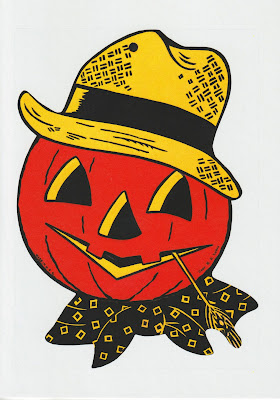Happy Halloween! The cards shared this week are reproductions of Halloween greeting cards originally produced by the Beistle Company. Laughing Elephant is a local shop that specializes in reproducing vintage art, cards, postcards, posters, and books. The card above is stamped Copr. H.E. Luhrs on the Jack-O-Lantern’s cheek. Below is another card from the same company, showing a black cat wearing a hat and a monocle with the same imprint on the bow tie.
The Beistle Company or Beistle manufactures holiday decorations and party goods. The company was founded in 1900 in Pennsylvania by Martin Luther Beistle. A line of Halloween products was introduced in the 1920s and helped popularize Halloween decorations in the United States. The company is still producing decorations and party goods today making it the oldest continuing manufacturer of such items.
Martin L. Beistle was working as a salesperson for the Pittsburg Art Calendar Company around 1900 when he had an idea to create artificial plants made from paper. He started the company in his home basement where he made artificial flowers and wooden products. The company expanded and was incorporated in 1907 and had moved from his basement to the second floor of a wagon shop in Oakville, Pennsylvania. Eventually further expansion allowed the company to move to larger facilities in Shippensburg, Pennsylvania. In 1910 Beistle was using imported technology and manufacturing honeycomb tissue, previously only available in Europe and Asia.
In 1920 Beistle partnered with the Paper Novelty Company and began creating a variety of paper decorations for Valentine’s Day, Easter, Halloween, Thanksgiving and Christmas. By this time the Beistle catalog had become popular and was best known for Halloween-themed items. In the 1920s and 1930s fortune-telling games for Halloween parties were added. Over 1,000 different Halloween-themed designs and decorations have been produced since the line was first introduced. Creepy Company, founded in 2015, also offers apparel, pins, and other products based on the Beistle designs.
After the death of Martin Luther Beistle in 1935 the ownership of the company passed on to his son-in-law Henry E. Luhrs and his family. Since the cards shared have the Luhrs mark on them they were either reproduced from earlier cards or were new designs from 1935 and onwards.
For additional information, see:
https://en.wikipedia.org/wiki/The_Beistle_Company





